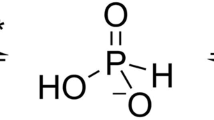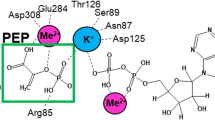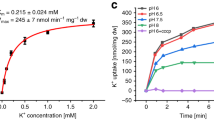Abstract
TRANSPORT of the essential nutrient phosphorus—primarily in the form of orthophosphate—into cells and organelles is highly specific. This is exemplified by the uptake of phosphate or its close analogue arsenate by bacterial cells by way of a high affinity active transport system dependent on a phosphate-binding protein; this system is unable to recognize other inorganic oxyanions and is, moreover, distinct from the one for sulphate transport1,2. The phosphate-binding protein is a member of a family of periplasmic proteins acting as initial high-affinity receptors for the osmotic shock-sensitive active transport systems or permeases for various sugars, amino acids, oligopeptides, and oxyanions2,3. We report here the highly refined 1.7 Å resolution X-ray structure of the liganded form of the phosphate-binding protein. The structure reveals the atomic features responsible for phosphate selectivity, either in monobasic or dibasic form, and the exclusion of sulphate. These features are fundamental to understanding phosphate transport systems and molecular recognition of charged substrates or ions in other biological processes.
This is a preview of subscription content, access via your institution
Access options
Subscribe to this journal
Receive 51 print issues and online access
$199.00 per year
only $3.90 per issue
Buy this article
- Purchase on Springer Link
- Instant access to full article PDF
Prices may be subject to local taxes which are calculated during checkout
Similar content being viewed by others
References
Medvecsky, N. & Rosenberg, H. Biochim. biophys. Acta 241, 494–506 (1971).
Quiocho, F. A. Phil. Trans. R. Soc. B341, 341–351 (1990).
Furlong, C. E. in Escherichia coli and Salmonella typhimurium: Cellular and Molecular Biology (ed. Neidhardt, F. C.), 768–796 (American Society for Microbiology, Washington, DC, 1987).
Surin, B. P. et al. J. Bact. 157, 772–778 (1984).
Magota, K. et al. J. Bact. 157, 909–917 (1984).
Medvecsky, N. & Rosenberg, H. Biochim. biophys. Acta 211, 158–168 (1970).
Kubena, B. D., Luecke, H., Rosenberg, H. & Quiocho, F. A. J. biol. Chem. 261, 7995–7996 (1986).
Luecke, H. thesis, Rice Univ. (1990).
Wang, B. C. Meth. Enzym. 115, 90–112 (1985).
Read, R. Acta crystallogr. A42, 140–149 (1986).
Bruenger, A. T., Kuriyan, J. & Karplus, M. Science 235, 458–460 (1987).
Hendrickson, W. A. Meth. Enzym. 115, 252–270 (1985).
Sack, J. S., Saper, M. A. & Quiocho, F. A. J. molec. Biol. 206, 171–191 (1989).
Speakman, J. C. Structure & Bonding 12, 141–199 (1972).
Sawyer, L. & James, M. N. G. Nature 295, 76–80 (1982).
Jacobson, B. L. & Quiocho, F. A. J. molec. Biol. 204, 783–787 (1988).
Pardee, A. B. J. biol. Chem. 241, 5886–5892 (1966).
Pflugrath, J. W. & Quiocho, F. A. Nature 314, 257–260 (1985).
Pflugrath, J. W. & Quiocho, F. A. J. molec. Biol. 200, 163–180 (1988).
Quiocho, F. A., Sack, J. S., & Vyas, N. K. Nature 327, 561–564 (1987).
Barnard, E. A., Garlison, M. G. & Seeburg, P. Trends Neurosci. 10, 502–509 (1987).
Cattrell, W. A. Science 242, 50–61 (1988).
Weiner, S. J., Kollman, P. A., Nguyen, D. T. & Case, D. A. J. comp. Chem. 7, 230–252 (1986).
Author information
Authors and Affiliations
Rights and permissions
About this article
Cite this article
Luecke, H., Quiocho, F. High specificity of a phosphate transport protein determined by hydrogen bonds. Nature 347, 402–406 (1990). https://doi.org/10.1038/347402a0
Received:
Published:
Issue Date:
DOI: https://doi.org/10.1038/347402a0
This article is cited by
-
Exploring potential of cellulose acetate sulfate films for sustainable packaging: tuning characteristics via sulfate group variation
Cellulose (2024)
-
Marine picocyanobacterial PhnD1 shows specificity for various phosphorus sources but likely represents a constitutive inorganic phosphate transporter
The ISME Journal (2023)
-
PCycDB: a comprehensive and accurate database for fast analysis of phosphorus cycling genes
Microbiome (2022)
-
Accumulation of ambient phosphate into the periplasm of marine bacteria is proton motive force dependent
Nature Communications (2020)
-
Are beryllium-containing biphenyl derivatives efficient anion sponges?
Journal of Molecular Modeling (2018)
Comments
By submitting a comment you agree to abide by our Terms and Community Guidelines. If you find something abusive or that does not comply with our terms or guidelines please flag it as inappropriate.



